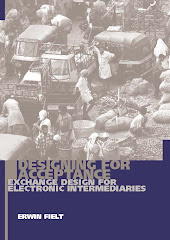Software as a Service (SaaS) can provide significant benefits to small and medium enterprises (SMEs) due to advantages like ease of access, 7*24 availability, and utility pricing. However, underlying the SaaS delivery model is often the assumption that SMEs will directly interact with the SaaS vendor and use a self-service approach. In practice, we see the rise of SaaS intermediaries who can support SMEs with sourcing and leveraging SaaS.
This paper reports on the roles of intermediaries and how they support SMEs with using SaaS. We conducted an empirical study of two SaaS intermediaries and analysed their business models, in particular their value propositions. We identified orientation (technology or customer) and alignment (operational or strategic) as themes for understanding their roles.
The contributions of this paper include: (1) the identification and description of SaaS intermediaries for SMEs based on an empirical study and (2) understanding the different roles of SaaS intermediaries, in particular a more basic role based on technology orientation and operational alignment and a more value adding role based on customer orientation and strategic alignment. We propose that SaaS intermediaries can address SaaS adoption and implementation challenges of SMEs by playing a basic role and can also aim to support SMEs in creating business value with SaaS based solutions by playing an added value role.
See here for more information.
Wednesday, November 26, 2014
Small and Medium Enterprises using Software as a Service: Exploring the different roles of intermediaries
Tuesday, August 19, 2014
Conceptualising Business Models: Definitions, Frameworks and Classifications
The business model concept is gaining traction in different disciplines but is still criticized for being fuzzy and vague and lacking consensus on its definition and compositional elements. In this paper we set out to advance our understanding of the business model concept by addressing three areas of foundational research: business model definitions, business model elements, and business model archetypes.
We define a business model as a representation of the value logic of an organization in terms of how it creates and captures customer value. This abstract and generic definition is made more specific and operational by the compositional elements that need to address the customer, value proposition, organizational architecture (firm and network level) and economics dimensions. Business model archetypes complement the definition and elements by providing a more concrete and empirical understanding of the business model concept.
The main contributions of this paper are (1) explicitly including the customer value concept in the business model definition and focusing on value creation, (2) presenting four core dimensions that business model elements need to cover, (3) arguing for flexibility by adapting and extending business model elements to cater for different purposes and contexts (e.g. technology, innovation, strategy) (4) stressing a more systematic approach to business model archetypes by using business model elements for their description, and (5) suggesting to use business model archetype research for the empirical exploration and testing of business model elements and their relationships.
See here for more information.
Wednesday, May 21, 2014
Exploring Shared Services from an IS Perspective: A Literature Review and Research Agenda
Shared services have gained significance as an organizational arrangement, in particular for support functions, to reduce costs, increase quality, and create new capabilities. The information systems (IS) function is amenable to sharing arrangements and information systems can enable sharing in other functional areas. However, despite being a promising area for IS research, literature on shared services in the IS discipline is scarce and scattered. There is still little consensus on what shared services is. Moreover, a thorough understanding of why shared services are adopted, who are involved, and how things are shared is lacking.
In this article, we set out to progress IS research on shared services by establishing a common ground for future research and proposing a research agenda to shape the field based on an analysis of the IS literature. We present a holistic and inclusive definition, discuss the primacy of economic-strategic objectives so far, and introduce conceptual frameworks for stakeholders and the notion of sharing. We also provide an overview of the theories and research methods applied. We propose a research agenda that addresses fundamental issues related to objectives, stakeholders, and the notion of sharing to lay the foundation for taking IS research on shared services forward.
See here for more information.
Posted by
Erwin Fielt
at
03:40
0
comments
![]()
Labels: information systems, paper, services, shared services
Wednesday, January 29, 2014
One-Stop Government Portals: Transformation or Navigation
E-government is seen as a promising approach for governments to improve their service towards citizens and become more cost-efficient in service delivery. This is often combined with one-stop government, which is a citizen-oriented approach stressing integrated provision of services from multiple departments via a single access point, the one-stop government portal. While the portal concept is gaining prominence in practice, there is little known about its status in academic literature. This hinders academics in building an accumulated body of knowledge around the concept and makes it hard for practitioners to access relevant academic insights on the topic. The objective of this study is to identify and understand the key themes of the one-stop government portal concept in academic, e-government research. A holistic analysis is provided by addressing different viewpoints: social-political, legal, organizational, user, security, service, data and information, and technical. As an overall finding, the authors conclude that there are two different approaches: a more pragmatic approach focuses on quick wins in particular related to usability and navigation and a more ambitious, transformational approach having far reaching social-political, legal, and organizational implications.
See here for more information.





